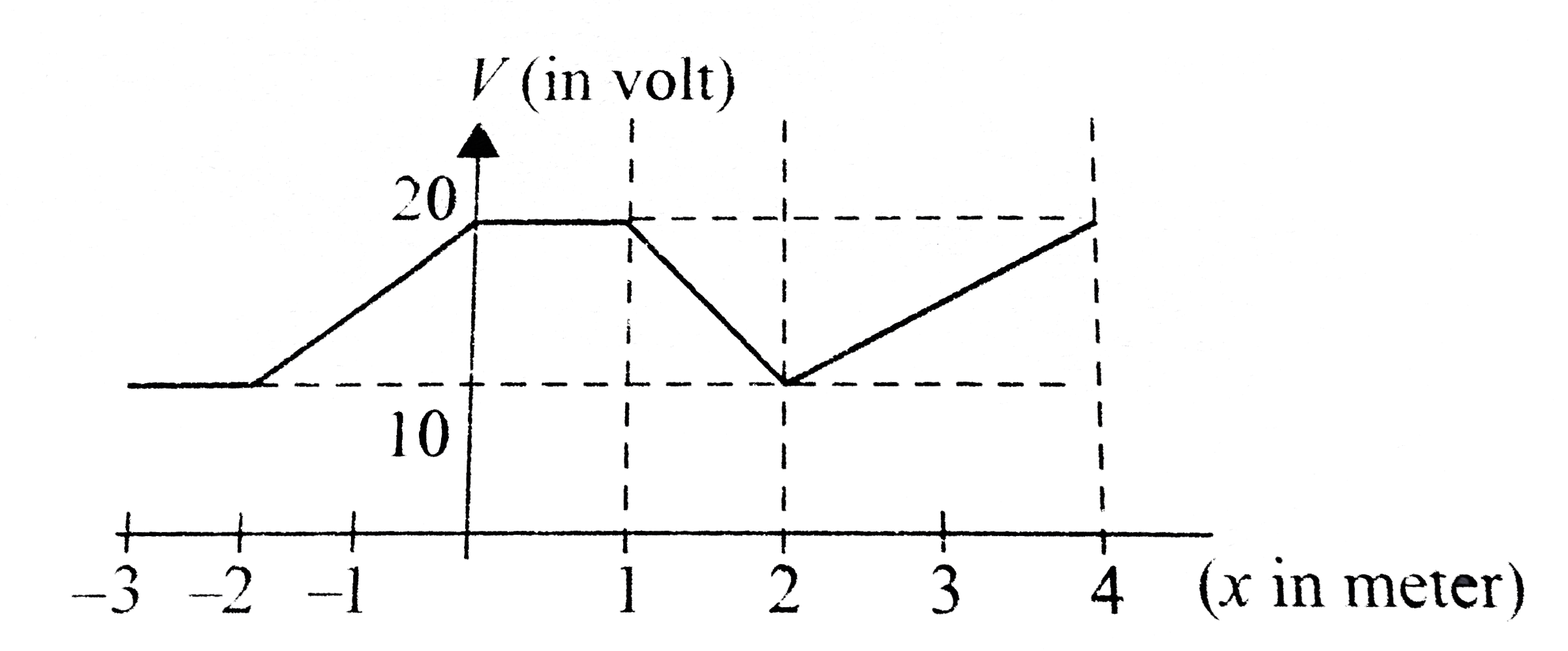(i) Find the field intensity if potential V=−kxy(k>0).
(ii) Draw the field pattern of the field in i.
To solve the problem step by step, we will first find the electric field intensity from the given electric potential and then draw the field pattern.
1. Understanding the Relationship:
The electric field intensity →E is related to the electric potential V by the equation:
→E=−∇V
where ∇V is the gradient of the potential.
2. Calculating the Gradient:
Given the potential V=−kxy, we need to compute the partial derivatives:
- The partial derivative with respect to x:
∂V∂x=−k⋅y
- The partial derivative with respect to y:
∂V∂y=−k⋅x
3. Substituting into the Electric Field Equation:
Now, substituting these derivatives into the equation for electric field:
→E=−(∂V∂x^i+∂V∂y^j)
This gives:
→E=−(−ky^i−(−kx)^j)
Simplifying this, we find:
→E=ky^i+kx^j
4. Final Expression for Electric Field Intensity:
Therefore, the electric field intensity is:
→E=ky^i+kx^j
(ii) Drawing the Field Pattern:
1. Understanding the Field Components:
From the expression →E=ky^i+kx^j, we can identify the components:
- Ex=ky
- Ey=kx
2. Finding the Relationship Between Ex and Ey:
The tangent of the angle θ that the field makes with the x-axis can be expressed as:
tanθ=EyEx=kxky=xy
3. Setting Up the Equation:
Rearranging gives us:
ydydx=x
or, integrating:
y2−x2=C
where C is a constant.
4. Identifying the Field Pattern:
The equation y2−x2=C represents hyperbolas in the xy-plane.
5. Sketching the Field Pattern:
The field lines will be hyperbolic curves, which can be drawn in the coordinate system.
Final Answer:
- The electric field intensity is:
→E=ky^i+kx^j
- The field pattern consists of hyperbolas described by the equation y2−x2=C.
The electric field intensity →E is related to the electric potential V by the equation:
→E=−∇V
where ∇V is the gradient of the potential.
Given the potential V=−kxy, we need to compute the partial derivatives:
- The partial derivative with respect to x:
∂V∂x=−k⋅y
- The partial derivative with respect to y:
∂V∂y=−k⋅x
Now, substituting these derivatives into the equation for electric field:
→E=−(∂V∂x^i+∂V∂y^j)
This gives:
→E=−(−ky^i−(−kx)^j)
Simplifying this, we find:
→E=ky^i+kx^j
Therefore, the electric field intensity is:
→E=ky^i+kx^j
From the expression →E=ky^i+kx^j, we can identify the components:
- Ex=ky
- Ey=kx
The tangent of the angle θ that the field makes with the x-axis can be expressed as:
tanθ=EyEx=kxky=xy
Rearranging gives us:
ydydx=x
or, integrating:
y2−x2=C
where C is a constant.
The equation y2−x2=C represents hyperbolas in the xy-plane.
The field lines will be hyperbolic curves, which can be drawn in the coordinate system.
- The electric field intensity is:
→E=ky^i+kx^j
- The field pattern consists of hyperbolas described by the equation y2−x2=C.
Topper's Solved these Questions
- ELECTRIC POTENTIALBOOK - CENGAGE PHYSICS ENGLISHCHAPTER - ELECTRIC POTENTIALEXERCISE - Examples
9 Videos
- ELECTRIC POTENTIALBOOK - CENGAGE PHYSICS ENGLISHCHAPTER - ELECTRIC POTENTIALEXERCISE - Exercise 3.1
23 Videos
- ELECTRIC FLUX AND GAUSS LAWBOOK - CENGAGE PHYSICS ENGLISHCHAPTER - ELECTRIC FLUX AND GAUSS LAWEXERCISE - MCQ s
38 Videos
- ELECTRICAL MEASURING INSTRUMENTSBOOK - CENGAGE PHYSICS ENGLISHCHAPTER - ELECTRICAL MEASURING INSTRUMENTSEXERCISE - M.C.Q
2 Videos
Similar Questions
A chargo q is uniformly distributed on a ring-shaped conductor of radius a. Find the field potential in an arbitrary point on the conductor's axis a distance I away from the plane in which the conductor lies. Using the relation between the potential and the field intensity, find the field intensity at this point.
View SolutionElectric potential at any point is V=−5x+3y+√15z, then the magnitude of the electric field is
View SolutionA rectangular loop of area 0.06 m2 is placed in a magnetic field of 0.3T with its plane (i) normal to the field (ii) inclined 30∘ to the field (iii) parallel to the field. Find the flux linked with the coil in each case.
View SolutionAt a certain distance from a point charge, the field intensity is 500Vm and the potential is −3000V. The distance to the charge and the magnitude of the charge respectively are
View SolutionAt a certain distance from a point charge, the field intensity is 500V/m and the potential is −3000V. The distance to the charge and the magnitude of the charge respectively are
View SolutionIf gravitational potential is V=xy2, find the gravitational field at (2,1)
View SolutionGravitational field intensity is given byE=Ax(A2+x2)32 then find out potential at x (Assume potential at infinity = 0)
View SolutionThe variation of electric potential for an electric field directed parallel to the x - axis is shown in (Fig. 3.110). Draw the variation of electric field strength with the x- axis.
 .
.
View SolutionAn electric charge 2×10−8C is placed at the point (1,2,4). At the point (3,2,1) , the electric
(i) potential will be 50V
(ii) field will have no Y-component
(iii) field will increase by a factor K if the space between the points is filled with a dielectric of constant K
(iv) field will be along Y-axis
View SolutionIt costs Rs. 5400 to fence a square field at Rs. 13.50 per metre . Find (i) the length of the side of the field (ii) the area of the field.
View Solution
